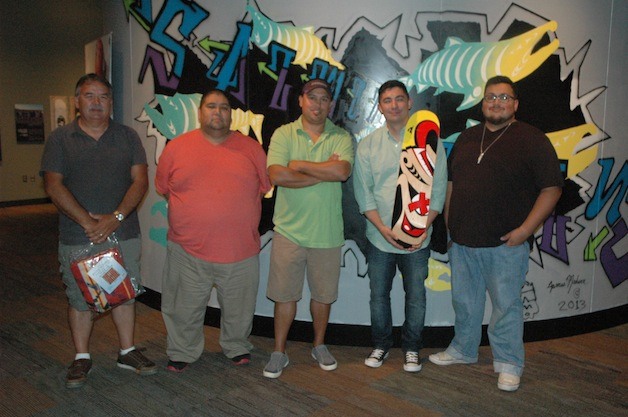TULALIP — Tulalip Tribal artists were joined by an internationally renowned Native American artist in kicking off “Ramp It Up: Skateboard Culture in Native America,” a new temporary exhibit at the Hibulb Cultural Center and Natural History Preserve, courtesy of the Smithsonian’s National Museum of the American Indian in New York.
Although the exhibit opened to the general public on the morning of Saturday, Aug. 10, a select audience was welcomed to a sneak peek of “Ramp It Up” on the evening of Friday, Aug. 9, by Tessa Campbell, assistant curator of the Hibulb Cultural Center, and Mytyl Hernandez, who managers its marketing, membership and public relations.
“Skateboarding has become very popular on tribal reservations, and the All Nations Skate Jam is one of the most popular skateboarding events in the world,” said Campbell, who noted that the exhibit includes 20 artifacts, 45 graphics and a host of film footage. “We’re borrowing this exhibit from the Smithsonian, but we wanted to give it a unique Tulalip flair, so we invited our Tribal artists to create a graffiti wall, within the Cultural Center, to go along with the exhibit. It took them two days of blood, sweat and tears to finish.”
“Our artists were happy to step outside of their comfort zone,” said Hernandez, who identified them as Steve and James Madison, Mike and Joe Gobin, and Ty Juvinel, after she echoed Campbell’s assertion that such youth-oriented exhibits meant a great deal to Hank Gobin, former director of the Cultural Center, who passed away earlier this year.
Campbell introduced Louie Gong, a Pacific Northwest Coast Salish artist whose mixed Nooksack Indian and Chinese heritage has inspired utilitarian artwork ranging from skateboards and wooden cell phone cases to shoes, the latter of which has earned him the nickname of the “Shoe Guy” for his low-cost, custom-made, one-of-a-kind shoe art.
“When I spoke with some Tulalip kids earlier today, they asked me, ‘Why shoes? Why skateboards?'” Gong said, as he showed off a skateboard deck he’d emblazoned with an artistic tribute to the survivalist virtues of the oft-maligned “Reservation Dog,” which lives off scraps with no owner. “As indigenous peoples, we recognize the resources of our environments. As an urban person, shoes and skateboards are part of my environment, so I use them as my canvas. I don’t like my art hanging on a wall in a gallery. It shouldn’t just be nice to look at. It should be out there, being used, sparking conversations about issues that we care about. Skate culture is a significant piece of our history, but it’s not fixed. This bridges the gap between what we want to teach our kids, and what they care about.”
Tulalip artist James Madison, who was named Artist of the Year by the Arts Council of Snohomish County, compared skateboarding to basketball, one of the primary pastimes of his own generation when they were younger, as a positive and productive outlet for young people. Like Gong, he hopes his artistic contributions to skate culture can help pass on the traditional tribal teachings of his grandparents to future generations.
“My grandpa would tell us the same stories, over and over and over, so many times that we’d tell him, ‘Please stop, we know this one,’ and now, my sons are saying that to me,” laughed Madison, as he recounted how he and his fellow Tulalip artists in attendance have worked together on a number of projects intended to help keep their culture alive. “Whether it’s wood or metal or glass, we work in all sorts of different mediums, because we’re always learning and growing as Tulalip people. We’re showing that our culture is still alive, not petrified. I’m proud to know what I know, and to share it with the community in this way, so that the young people can see what we’re doing.”
“Ramp it Up” will remain on view at the Hibulb Cultural Center through Oct. 13, before continuing on its 12-city national tour.



